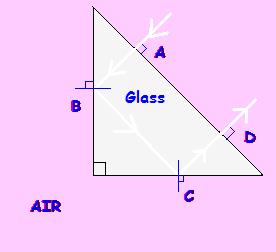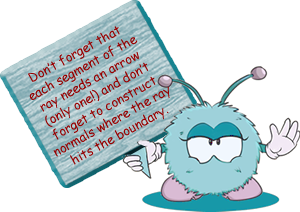|
A 45o prism
can turn a ray through 90o or through 180o
When drawing these
diagrams use a ruler and a protractor and ensure your digrams are neat
and large enough to label accurately. Always tell the examiner what is
happening at each boundary.
Turning a ray through
90o

- At boundary A the
angle of incidence is 0o therefore the ray goes through undeviated.
- At boundary B the
angle of incidence is 45o therefore the ray undergoes total
internal reflection as it is a bigger angle than the critical angle
of glas (42o).
- At boundary C the
angle of incidence is 0o therefore the ray goes through undeviated.
Turning
a ray through 180o

- At boundary A the
angle of incidence is 0o therefore the ray goes through undeviated.
- At boundary B the
angle of incidence is 45o therefore the ray undergoes total
internal reflection as it is a bigger angle than the critical angle
of glas (42o).
 At boundary C the
angle of incidence is 45o therefore the ray undergoes total
internal reflection as it is a bigger angle than the critical angle
of glas (42o). At boundary C the
angle of incidence is 45o therefore the ray undergoes total
internal reflection as it is a bigger angle than the critical angle
of glas (42o).- At boundary D the
angle of incidence is 0o therefore the ray goes through undeviated.
The advantage of using
a prism rather than mirrors to change the path of the ray is that 100%
of the light energy changes direction - there is no absorption at each
boundary as there would be with normal reflection.
|